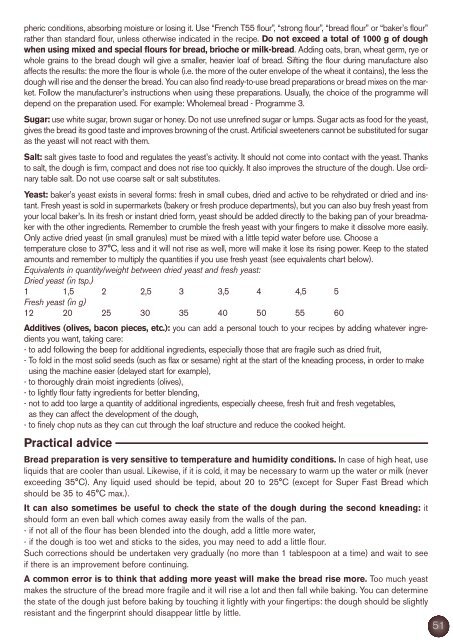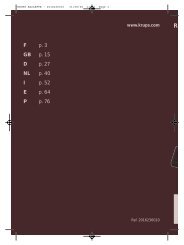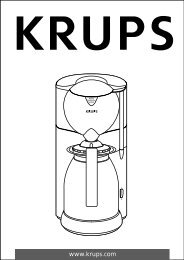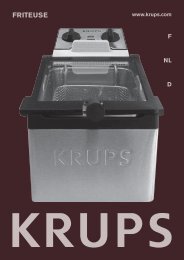2 - Krups
2 - Krups
2 - Krups
Create successful ePaper yourself
Turn your PDF publications into a flip-book with our unique Google optimized e-Paper software.
pheric conditions, absorbing moisture or losing it. Use “French T55 flour”, “strong flour”, “bread flour” or “baker’s flour”<br />
rather than standard flour, unless otherwise indicated in the recipe. Do not exceed a total of 1000 g of dough<br />
when using mixed and special flours for bread, brioche or milk-bread. Adding oats, bran, wheat germ, rye or<br />
whole grains to the bread dough will give a smaller, heavier loaf of bread. Sifting the flour during manufacture also<br />
affects the results: the more the flour is whole (i.e. the more of the outer envelope of the wheat it contains), the less the<br />
dough will rise and the denser the bread. You can also find ready-to-use bread preparations or bread mixes on the market.<br />
Follow the manufacturer’s instructions when using these preparations. Usually, the choice of the programme will<br />
depend on the preparation used. For example: Wholemeal bread - Programme 3.<br />
Sugar: use white sugar, brown sugar or honey. Do not use unrefined sugar or lumps. Sugar acts as food for the yeast,<br />
gives the bread its good taste and improves browning of the crust. Artificial sweeteners cannot be substituted for sugar<br />
as the yeast will not react with them.<br />
Salt: salt gives taste to food and regulates the yeast’s activity. It should not come into contact with the yeast. Thanks<br />
to salt, the dough is firm, compact and does not rise too quickly. It also improves the structure of the dough. Use ordinary<br />
table salt. Do not use coarse salt or salt substitutes.<br />
Yeast: baker’s yeast exists in several forms: fresh in small cubes, dried and active to be rehydrated or dried and instant.<br />
Fresh yeast is sold in supermarkets (bakery or fresh produce departments), but you can also buy fresh yeast from<br />
your local baker’s. In its fresh or instant dried form, yeast should be added directly to the baking pan of your breadmaker<br />
with the other ingredients. Remember to crumble the fresh yeast with your fingers to make it dissolve more easily.<br />
Only active dried yeast (in small granules) must be mixed with a little tepid water before use. Choose a<br />
temperature close to 37°C, less and it will not rise as well, more will make it lose its rising power. Keep to the stated<br />
amounts and remember to multiply the quantities if you use fresh yeast (see equivalents chart below).<br />
Equivalents in quantity/weight between dried yeast and fresh yeast:<br />
Dried yeast (in tsp.)<br />
1 1,5 2 2,5 3 3,5 4 4,5 5<br />
Fresh yeast (in g)<br />
12 20 25 30 35 40 50 55 60<br />
Additives (olives, bacon pieces, etc.): you can add a personal touch to your recipes by adding whatever ingredients<br />
you want, taking care:<br />
- to add following the beep for additional ingredients, especially those that are fragile such as dried fruit,<br />
- To fold in the most solid seeds (such as flax or sesame) right at the start of the kneading process, in order to make<br />
using the machine easier (delayed start for example),<br />
- to thoroughly drain moist ingredients (olives),<br />
- to lightly flour fatty ingredients for better blending,<br />
- not to add too large a quantity of additional ingredients, especially cheese, fresh fruit and fresh vegetables,<br />
as they can affect the development of the dough,<br />
- to finely chop nuts as they can cut through the loaf structure and reduce the cooked height.<br />
Practical advice<br />
Bread preparation is very sensitive to temperature and humidity conditions. In case of high heat, use<br />
liquids that are cooler than usual. Likewise, if it is cold, it may be necessary to warm up the water or milk (never<br />
exceeding 35°C). Any liquid used should be tepid, about 20 to 25°C (except for Super Fast Bread which<br />
should be 35 to 45°C max.).<br />
It can also sometimes be useful to check the state of the dough during the second kneading: it<br />
should form an even ball which comes away easily from the walls of the pan.<br />
- if not all of the flour has been blended into the dough, add a little more water,<br />
- if the dough is too wet and sticks to the sides, you may need to add a little flour.<br />
Such corrections should be undertaken very gradually (no more than 1 tablespoon at a time) and wait to see<br />
if there is an improvement before continuing.<br />
A common error is to think that adding more yeast will make the bread rise more. Too much yeast<br />
makes the structure of the bread more fragile and it will rise a lot and then fall while baking. You can determine<br />
the state of the dough just before baking by touching it lightly with your fingertips: the dough should be slightly<br />
resistant and the fingerprint should disappear little by little.<br />
51









